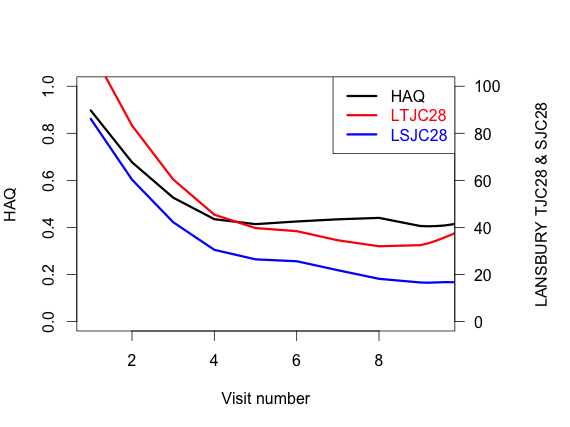Session Information
Date: Monday, November 14, 2016
Title: Rheumatoid Arthritis – Clinical Aspects - Poster II: Co-morbidities and Complications
Session Type: ACR Poster Session B
Session Time: 9:00AM-11:00AM
Background/Purpose:
Residual disease activity impacts functional status and quality of life (QoL) in patients with early rheumatoid arthritis (ERA). Large weight bearing joints are more likely to impact function such as walking than small non-weight bearing joints although the effect may be task dependent. The Lansbury Articular Index (LAI) weights large joints more than small joints thus may give a better estimate of overall disease burden with respect to large joint function. The Health Assessment Questionnaire (HAQ) seems to weigh upper extremity tasks more than lower extremity or weight bearing tasks. In a large multicenter cohort of ERA patients, we therefore sought to determine associations of LAI with HAQ, QoL and baseline disability status and whether changes in the LAI trajectory more closely reflected the evolution of the HAQ trajectory than the standard joint count measures.Methods:
We used data from subjects with ERA (less than 1 year symptom duration at first visit) followed in a multicentre Early Arthritis Cohort. Arthritis activity measures (DAS28, tender 28 joint count (tjc28), swollen 28 joint count (sjc28), function (Health Assessment questionnaire; HAQ) QoL (SF12 physical (PCS) and mental (MCS) indices) and work status were captured per study protocol. The LAI based on 28 joints was calculated separately for swollen (LS28) and tender (LT28) joint counts. The impact of LS28, LT28 on baseline disability status was modeled using logistic regression. Individuals’ trajectories for each measure (HAQ, DAS28, TJC28, SJC28, LT28,LS28) were visualized with LOESS plots and marginal trajectories by variable plotted. Each measure’s longitudinal trajectory was fitted using the best fitting fractional polynomials. Each individual disease activity trajectory was then jointly modelled with the HAQ longitudinally (joint modelling). Correlations between each pair of joint trajectories (HAQ with TJC28 or SJC28 or LT28 or LS28) were calculated.Results:
ERA subjects (n=2133, 73% female; baseline mean (SD) Age 53(15) years, DAS 5.1(1.4)) were followed for median (IQR) 24(10,48) months. At last visit 44 % were in remission (DAS28<2.6). Combining all visits, the LS28 strongly correlated with SJC28 (r= 0.9 p<0.0001), PCS (r=-0.4 p<0.0001) and HAQ (r= 0.4 p<0.0001). The LT28 correlated with the TJC28 (0.9 p<0.001), PCS (r=-0.5 p<0.0001) and HAQ (0.5 p<0.0001). Correlations were even stronger with the full LAI (42 joints). Disability or sick leave at baseline (6% of cohort) was associated with higher LT28 (OR 1.003 p=0.001) and higher TJC28 (OR 1.071 p<0.0001) in separate logistic regression models that included age. The HAQ trajectory was highly correlated with the trajectories for DAS28 (r=0.83), LT28 (r=0.83), and TJC28 (r=0.85) and less strongly with trajectories for LS28(r= 0.59) and SJC28 (r=0.61).Conclusion:
The trajectories of function (HAQ) and both Lansbury and standard joint counts are highly correlated over time in ERA. The LAI performed similarly to standard joint counts which are easier to determine. Although type of occupation was not addressed and likely influences the impact of lower extremity involvement, both LT28 and TJ28 associated with baseline work disability.
Disclosure: S. H. L. Lim, None; S. J. Bartlett, None; G. Boire, None; B. Haraoui, None; E. Keystone, Abbott, Amgen, AstraZeneca, BMS, Hoffman-LaRoche, Janssen, Eli Lilly and Company, Novartis, Pfizer, Sanofi-Aventis, UCB, 2,Abbott, AstraZeneca, Biotest, BMS, Crescendo, Hoffmann-LaRoche, Genentech, Janssen, Eli Lilly and Company, Merck, Pfizer, UCB, 5,Abbott, AstraZeneca, BMS Canada, Hoffmann-LaRoche, Janssen, Pfizer, UCB, Amgen, 9; J. C. Thorne, abbvie, 5,Amgen, 5,AstraZeneca, 5,Bristol-Myers Squibb, 5,Centocor, Inc., 5,Celgene, 5,Genzyme Corporation, 5,hospira, 5,Pfizer Inc, 5,Roche Pharmaceuticals, 5,Genzyme Corporation, 8,Medac Pharma, 8,Antares, 8,Abbvie, 2,Amgen, 2,AstraZeneca, 2,Celgene, 2,Eli Lilly and Company, 2,Novartis Pharmaceutical Corporation, 2,Pfizer Inc, 2; J. E. Pope, AbbVie, Actelion, Amgen, BMS, Hospira, Janssen, Lilly, Merck, Novartis, Pfizer, Roche, Sanofi, UCB, 5; D. Tin, None; V. P. Bykerk, AbbVie, Bristol-Myers Squibb, Pfizer, Roche/Genentech, Regeneron, and UCB Pharma, 5; C. Hitchon, None.
To cite this abstract in AMA style:
Lim SHL, Bartlett SJ, Boire G, Haraoui B, Keystone E, Thorne JC, Pope JE, Tin D, Bykerk VP, Hitchon C. Longitudinal Trajectories of the Weighted Lansbury Articular Indices and Standard Joint Counts Are Similarly Correlated with Trajectories of Physical Function in Early Inflammatory Arthritis [abstract]. Arthritis Rheumatol. 2016; 68 (suppl 10). https://acrabstracts.org/abstract/longitudinal-trajectories-of-the-weighted-lansbury-articular-indices-and-standard-joint-counts-are-similarly-correlated-with-trajectories-of-physical-function-in-early-inflammatory-arthritis/. Accessed .« Back to 2016 ACR/ARHP Annual Meeting
ACR Meeting Abstracts - https://acrabstracts.org/abstract/longitudinal-trajectories-of-the-weighted-lansbury-articular-indices-and-standard-joint-counts-are-similarly-correlated-with-trajectories-of-physical-function-in-early-inflammatory-arthritis/

